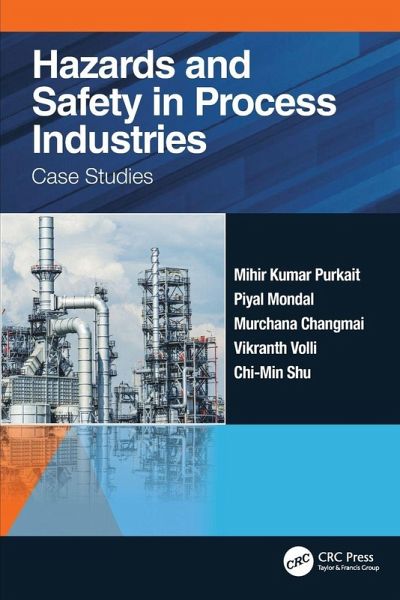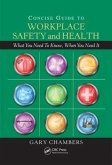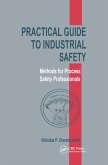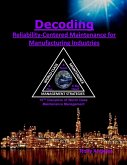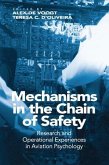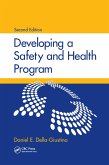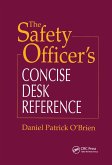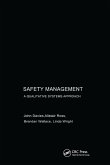Mihir Kumar Purkait, Piyal Mondal, Murchana Changmai, Vikranth Volli, Chi-Min Shu
Hazards and Safety in Process Industries
Case Studies
Mihir Kumar Purkait, Piyal Mondal, Murchana Changmai, Vikranth Volli, Chi-Min Shu
Hazards and Safety in Process Industries
Case Studies
- Broschiertes Buch
- Merkliste
- Auf die Merkliste
- Bewerten Bewerten
- Teilen
- Produkt teilen
- Produkterinnerung
- Produkterinnerung
The aim of this book is to elucidate the hazards and preventive measures for a few of specific industrial process. Starting with overview of the prevalent industrial accidents, types of hazards and safety provisions, the book contains nineteen chapters covering unique case study including causes, results and discussion, and protective measures.
Andere Kunden interessierten sich auch für
![Concise Guide to Workplace Safety and Health Concise Guide to Workplace Safety and Health]() Gary ChambersConcise Guide to Workplace Safety and Health126,99 €
Gary ChambersConcise Guide to Workplace Safety and Health126,99 €![Practical Guide to Industrial Safety Practical Guide to Industrial Safety]() Nicholas P CheremisinoffPractical Guide to Industrial Safety92,99 €
Nicholas P CheremisinoffPractical Guide to Industrial Safety92,99 €![Decoding Reliability-Centered Maintenance Process for Manufacturing Industries Decoding Reliability-Centered Maintenance Process for Manufacturing Industries]() Rolly AngelesDecoding Reliability-Centered Maintenance Process for Manufacturing Industries74,99 €
Rolly AngelesDecoding Reliability-Centered Maintenance Process for Manufacturing Industries74,99 €![Mechanisms in the Chain of Safety Mechanisms in the Chain of Safety]() Teresa C D'OliveiraMechanisms in the Chain of Safety74,99 €
Teresa C D'OliveiraMechanisms in the Chain of Safety74,99 €![Developing a Safety and Health Program, Second Edition Developing a Safety and Health Program, Second Edition]() Daniel E Della-GiustinaDeveloping a Safety and Health Program, Second Edition91,99 €
Daniel E Della-GiustinaDeveloping a Safety and Health Program, Second Edition91,99 €![The Safety Officer's Concise Desk Reference The Safety Officer's Concise Desk Reference]() Daniel Patrick O'BrienThe Safety Officer's Concise Desk Reference91,99 €
Daniel Patrick O'BrienThe Safety Officer's Concise Desk Reference91,99 €![Safety Management Safety Management]() John DaviesSafety Management91,99 €
John DaviesSafety Management91,99 €-
-
-
The aim of this book is to elucidate the hazards and preventive measures for a few of specific industrial process. Starting with overview of the prevalent industrial accidents, types of hazards and safety provisions, the book contains nineteen chapters covering unique case study including causes, results and discussion, and protective measures.
Hinweis: Dieser Artikel kann nur an eine deutsche Lieferadresse ausgeliefert werden.
Hinweis: Dieser Artikel kann nur an eine deutsche Lieferadresse ausgeliefert werden.
Produktdetails
- Produktdetails
- Verlag: CRC Press
- Seitenzahl: 334
- Erscheinungstermin: 4. Oktober 2024
- Englisch
- Abmessung: 234mm x 156mm x 19mm
- Gewicht: 494g
- ISBN-13: 9780367516529
- ISBN-10: 0367516527
- Artikelnr.: 71648267
- Herstellerkennzeichnung
- Libri GmbH
- Europaallee 1
- 36244 Bad Hersfeld
- gpsr@libri.de
- Verlag: CRC Press
- Seitenzahl: 334
- Erscheinungstermin: 4. Oktober 2024
- Englisch
- Abmessung: 234mm x 156mm x 19mm
- Gewicht: 494g
- ISBN-13: 9780367516529
- ISBN-10: 0367516527
- Artikelnr.: 71648267
- Herstellerkennzeichnung
- Libri GmbH
- Europaallee 1
- 36244 Bad Hersfeld
- gpsr@libri.de
Dr. Mihir Kumar Purkait is a Professor in the Department of Chemical Engineering and Head Centre for the Environment at Indian Institute of Technology Guwahati (IITG). Prior to joining as faculty in IITG (2004), he has received his PhD and M. Tech in Chemical Engineering from Indian Institute of Technology, Kharagpur (IITKGP) after completing his B. Tech and B. Sc (Hons) in Chemistry from University of Calcutta. He has received several awards like; Dr. A.V. Rama Rao Foundation's Best PhD Thesis and Research Award in Chemical Engineering from IIChE (2007), BOYSCAST Fellow award (2009-10) from the DST, Young Engineers Award in the field of Chemical Engineering from the Institute of Engineers (India, 2009), Young Scientist Medal award from the Indian National Science Academy (INSA, 2009). Prof. Purkait is a Fellow of Royal Society of Chemistry (FRSC) UK, and Fellow of Institute of Engineers (FIE) India. He is the director of 2 incubated company (viz. RD Grow Green India Pvt. Ltd. and Vixudha Bio Products Ltd.). He is also technical advisor of Gammon India Ltd and Indian Oil Corporation, Bethkuchi for their treatment plant. His current research activities are focused in four distinct areas viz. i) advanced separation technologies, ii) waste to energy, iii) smart materials for various applications and iv) process intensification. In each of the area, his goal is to synthesis stimuli responsive materials and to develop a more fundamental understanding of the factors governing the performance of the chemical and biochemical processes. He has more than 20 years of experience in academics and research and published more than 200 papers in different reputed journals. He has 8 patents and completed 24 sponsored and consultancy projects from various funding agencies. Prof. Purkait has guided 18 PhD students. He has authored 6 books in CRC press, Academic press and Springer. Dr. Piyal Mondal received his B Tech in Chemical Engineering from NIT Durgapur. He pursued M-Tech and PhD from IIT Guwahati in Chemical Engineering. His research work is dedicated to preparation of zero-valent nanomaterial through green synthesis methodology, as well metal-metal nano-composite material. Research work focuses on the hazardous analysis of the synthesized materials towards treatment of drinking water. Moreover his studies also include polymeric membrane preparation for wastewater treatment, protein separation, value added product separation from biogenic source etc. Fabricating prototype for analysing specific contaminant through photo-luminescent activity is also a part of his study. He has authored 3 book, 2 by Elsevier (AP, ISBN: 9780128139615, 9780128188019), one by CRC Press (Taylor & Francis, ISBN: 9781138393417) published 8 and already submitted 7 papers in international journals. He has received several awards in his field in international and national conferences. His contribution is essential in every steps starting from formulation of proposal to final submission of book. Dr. Murchana Changmai, Research Associate at Hindustan Petroleum Corporation Limited R&D Centre is an active researcher. Currently she works in the field of kinetic modeling for catalyst deactivation, oxidative and extractive desulfurization studies. She completed her PhD (2019) and Masters (2014) from Indian Institute of Technology Guwahati where she extensively worked in the field of water treatment utilizing various methods such as membrane separation, electrocoagulation and adsorption. She also has experience in the fabrication of inorganic membranes and adsorbents (nanoparticles, organic adsorbents and composite adsorbents). She has also done internships at Gifu University, Japan and SeoulTech, South Korea during her tenure as a PhD scholar. Dr. Changmai has published 10 papers, 2 book chapters and filed 1 patent as of now. Being in the petroleum industry, she is aware of the basic SOPs followed for any experiment and MSDS, HAZOP necessities for the incident free work environment and the safety of all its researchers. Dr. Vikranth Volli is an Assistant Professor in the Department of Safety, Health and Environment, at National Yunlin University of Science and Technology (YunTech), Douliou, Taiwan. Before joining YunTech, he has received his Ph.D. in Chemical Engineering from Indian Institute of Technology, Guwahati and M.Tech from National Institute of Technology, Rourkela after completing his B.Tech in Chemical Engineering from Jawaharlal Nehru Technological University, Hyderabad, India. His research work is dedicated to studies relating the thermal behavior, oxidative stability, and hazard analysis of ionic liquids, agricultural residues, ester based lube, and commercial oils. He has also studied the synthesis of catalysts and value-added products from industrial wastes (fly ash and red mud) and their application in biodiesel production. He has published numerous research papers in international journals of repute. Dr. Shu was a Distinguished Chair Professor and Academic Vice President of National Yunlin University of Science and Technology in Taiwan. He was the first Taiwanese professor to receive the North American Thermal Analysis Society (NATAS) Fellow Award (2011) for his technical service and professional contributions as a recognition of this important contribution. Furthermore, he was the first Taiwanese professor to be elected as an American Institute of Chemical Engineers (AIChE) Fellow in 2016 for technical service and professional contributions, followed by the NATAS Mettler Toledo Award, which is the highest honor in Thermal Analysis internationally for the year 2017. He was the 4th ethnic Chinese recipient in 50 years. In 2018, he obtained the two Fellows from the Royal Society of Chemistry (RSC) and The Institution of Engineering and Technology (IET. Dr. Shu also served as an editorial board member for various reputed science journals, such as PSP (Process Safety Progress, SCI), JSR (Journal of Safety Research, SSCI) and JLPPI (Journal of Loss Prevention in the Process Industries, SCI). His service and stellar performance towards the sustainable development in process industries brought in many accolades and awards, such as the Outstanding Research Award in 2007, 2010, 2017, and the Outstanding Academic-Industrial Collaboration Award in 2014; winning both the awards is unique in the history of YunTech as a top 1% performer among 360 faculty members since its establishment. From 2011, he is among the first five Distinguished Professors of YunTech and in 2016 was promoted as Distinguished Chair Professor. With 248 SCI publications in 18 years, he has spear-headed numerous disaster management programs and monitored crisis management events through chemical engineering across the Asian continent.
1. Introduction to industrial safety and hazard. 2. Caprolactum storage
tank accident: Root cause analysis. 3. Fire explosion accident caused by
static electricity in a propylene plant. 4. Thermal hazard accident during
hydrogen peroxide mixing with propanone: Case study. 5. Hydroelectric power
plant fire accident: Fire dynamics simulator (FDS) . 6. Thermal accident of
methyl ethyl ketone peroxide plant: Calorimetric analysis. 7. Case study on
the integrated self-assessment module for fire rescue, safety in a chemical
plant. 8. Chemical releases in a semiconductor plant: Emergency response
study. 9. Thermal hazard and safety during combustion of 1-butylimidazolium
nitrate . 10. Safety and flammability analysis for fuel-air-diluent
mixtures plant. 11. Advanced calorimetric technology for kinetic and
thermal safety analysis of Tert-Butylperoxy-3,5,5-Trimethylhexanoate. 12.
Thermal hazard analysis and its application on process safety assessments.
13. Safety of flammable liquid mixtures. 14. Calorimetric approach on the
thermal hazard assessment of Cumene Hydroperoxide. 15. Evaluation of the
information system of maintenance efficiency in petrochemical plants. 16.
Challenges in emerging economies to industry 4.0 initiatives for supply
chain sustainability. 17. Spatial features for heavy metal pollution and
ecological risk assessment during mining. 18. Evaluation of human factors
risk and management in process safety engineering. 19. Analysis of off-site
emergency procedures and reciprocation for nuclear accidents.
tank accident: Root cause analysis. 3. Fire explosion accident caused by
static electricity in a propylene plant. 4. Thermal hazard accident during
hydrogen peroxide mixing with propanone: Case study. 5. Hydroelectric power
plant fire accident: Fire dynamics simulator (FDS) . 6. Thermal accident of
methyl ethyl ketone peroxide plant: Calorimetric analysis. 7. Case study on
the integrated self-assessment module for fire rescue, safety in a chemical
plant. 8. Chemical releases in a semiconductor plant: Emergency response
study. 9. Thermal hazard and safety during combustion of 1-butylimidazolium
nitrate . 10. Safety and flammability analysis for fuel-air-diluent
mixtures plant. 11. Advanced calorimetric technology for kinetic and
thermal safety analysis of Tert-Butylperoxy-3,5,5-Trimethylhexanoate. 12.
Thermal hazard analysis and its application on process safety assessments.
13. Safety of flammable liquid mixtures. 14. Calorimetric approach on the
thermal hazard assessment of Cumene Hydroperoxide. 15. Evaluation of the
information system of maintenance efficiency in petrochemical plants. 16.
Challenges in emerging economies to industry 4.0 initiatives for supply
chain sustainability. 17. Spatial features for heavy metal pollution and
ecological risk assessment during mining. 18. Evaluation of human factors
risk and management in process safety engineering. 19. Analysis of off-site
emergency procedures and reciprocation for nuclear accidents.
1. Introduction to industrial safety and hazard. 2. Caprolactum storage
tank accident: Root cause analysis. 3. Fire explosion accident caused by
static electricity in a propylene plant. 4. Thermal hazard accident during
hydrogen peroxide mixing with propanone: Case study. 5. Hydroelectric power
plant fire accident: Fire dynamics simulator (FDS) . 6. Thermal accident of
methyl ethyl ketone peroxide plant: Calorimetric analysis. 7. Case study on
the integrated self-assessment module for fire rescue, safety in a chemical
plant. 8. Chemical releases in a semiconductor plant: Emergency response
study. 9. Thermal hazard and safety during combustion of 1-butylimidazolium
nitrate . 10. Safety and flammability analysis for fuel-air-diluent
mixtures plant. 11. Advanced calorimetric technology for kinetic and
thermal safety analysis of Tert-Butylperoxy-3,5,5-Trimethylhexanoate. 12.
Thermal hazard analysis and its application on process safety assessments.
13. Safety of flammable liquid mixtures. 14. Calorimetric approach on the
thermal hazard assessment of Cumene Hydroperoxide. 15. Evaluation of the
information system of maintenance efficiency in petrochemical plants. 16.
Challenges in emerging economies to industry 4.0 initiatives for supply
chain sustainability. 17. Spatial features for heavy metal pollution and
ecological risk assessment during mining. 18. Evaluation of human factors
risk and management in process safety engineering. 19. Analysis of off-site
emergency procedures and reciprocation for nuclear accidents.
tank accident: Root cause analysis. 3. Fire explosion accident caused by
static electricity in a propylene plant. 4. Thermal hazard accident during
hydrogen peroxide mixing with propanone: Case study. 5. Hydroelectric power
plant fire accident: Fire dynamics simulator (FDS) . 6. Thermal accident of
methyl ethyl ketone peroxide plant: Calorimetric analysis. 7. Case study on
the integrated self-assessment module for fire rescue, safety in a chemical
plant. 8. Chemical releases in a semiconductor plant: Emergency response
study. 9. Thermal hazard and safety during combustion of 1-butylimidazolium
nitrate . 10. Safety and flammability analysis for fuel-air-diluent
mixtures plant. 11. Advanced calorimetric technology for kinetic and
thermal safety analysis of Tert-Butylperoxy-3,5,5-Trimethylhexanoate. 12.
Thermal hazard analysis and its application on process safety assessments.
13. Safety of flammable liquid mixtures. 14. Calorimetric approach on the
thermal hazard assessment of Cumene Hydroperoxide. 15. Evaluation of the
information system of maintenance efficiency in petrochemical plants. 16.
Challenges in emerging economies to industry 4.0 initiatives for supply
chain sustainability. 17. Spatial features for heavy metal pollution and
ecological risk assessment during mining. 18. Evaluation of human factors
risk and management in process safety engineering. 19. Analysis of off-site
emergency procedures and reciprocation for nuclear accidents.

